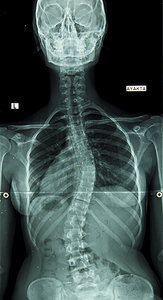I recently came across an article on "adult scoliosis"1 in The New York Times. According to the article, this seems to be a newly recognized condition: adult-onset scoliosis, "an asymmetrical curvature of the spine that, if unchecked, could eventually lead to a shorter and more crooked disability by entrapped spinal nerves, and dependency on a walker to maintain balance."
Scoliosis Basics
Going back to the dustbins of my memory, I recall that a scoliosis is a lateral curvature of the spine – any lateral curve of the spine.2 If you tilt 1 degree to one side, that is a scoliosis. This is more regional and the curve is spread over several spinal levels.
Alternatively, the "disease" process of scoliosis is different in that the curve is a hard angulation at one spinal level, more than 30 degrees, and must be shown to be measurably increasing within a window of time. This process is most often seen in younger adolescents when the body is growing at a rapid rate.
Life is stress. Gravity is always there. Desk work, driving, carrying groceries, and yard work all put stresses on the back. Things get twisted and pulled all the time. Almost every patient we see has some degree of postural torsion, and this changes with activity and over time.
 Most people have a tilt.3 A short leg is almost an expected finding.4 Certainly in kids, the physical stresses of activity – or inactivity – can lead to spinal stress and torsion that will then manifest as a postural imbalance. I can think of no better way to address this epidemic than with chiropractic management.
Most people have a tilt.3 A short leg is almost an expected finding.4 Certainly in kids, the physical stresses of activity – or inactivity – can lead to spinal stress and torsion that will then manifest as a postural imbalance. I can think of no better way to address this epidemic than with chiropractic management.
The Problem
Nowhere in the article is there any mention of chiropractic care. Recommendations are given for PT, yoga and stretching, massage, shoe lifts, and even Botox injections. One mother and daughter both got spinal braces. But how is it that chiropractic care was overlooked as a treatment option? We are the experts in spinal health, care and management.
As a profession, we should be all over this. If anyone has a concern over spinal imbalance, a short leg or functional back pain, we should be the first treatment option considered. What are you doing to address this in your office – do your patients know you can help manage scoliosis in adults, as well as in kids?
Our Role: Education and Management
When I have a patient with a short leg, I tell them about it and explain how the hips are torqued to cause that finding. During my evaluation, I will often demonstrate how one sacroiliac is not moving compared to the other. I can show them their spinal imbalances. I can perform and review a foot scan to show the discrepancy and secondary spinal imbalances.
The tools are there – we need to make sure we use them to educate our patients. I would also note that the ACA has a great patient information sheet on scoliosis.
As always, a good exam followed by a complete narrative is necessary – it is the standard of care, and one more way we have to show that were are capable of evaluating and managing these conditions. There are no quick shortcuts in a good examination. Take the time to fully evaluate the patient so your diagnosis is correct and your treatment is appropriate. In today's media-heavy environment, patients hear wild claims and get distracted very quickly. Make sure your patients know you are in control and able to take care of them.
References
- Brody JE. "Scoliosis Can Hit Well Past Adolescence." The New York Times, Oct. 21, 2013.
- Hoppenfeld S. Physical Examination of the Spine and Extremities. San Mateo, CA: Appleton & Lange, 1976.
- Briggs DR. "Things I Have Learned: The Leaning Low Back." Dynamic Chiropractic, Nov. 19, 2007.
- Briggs DR. "Things I Have Learned: The Short-Leg Dilemma." Dynamic Chiropractic, Feb. 26, 2005.
Click here for more information about Douglas R. Briggs, DC, Dipl. Ac. (IAMA), DAAPM, EMT.





